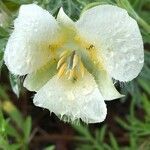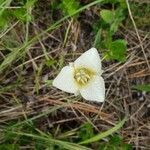Stems usually not branching, straight, scapelike, stout, 1–3 dm. Leaves: basal 1–3 dm × 5–15 mm, usually shorter than stem. Inflorescences subumbellate, 1–5-flowered; bracts 2–several, lanceolate to linear, unequal, 1–5 cm, apex acuminate; peduncle stout, becoming strongly deflexed in fruit. Flowers erect or spreading; perianth yellowish white, sometimes streaked with purple, open, campanulate; sepals shorter than petals; petals oblong-lanceolate, clawed, adaxial surface densely hairy, margins fringed laterally and moderately bearded on proximal 1/2 distal to claw with slender, flexuous hairs, apex acute or obtuse; glands short, nearly round, depressed, typically bordered proximally by dark-colored, deeply fringed membrane, adaxial surface covered with short, thick hairs; filaments shorter than or equaling anthers; anthers lanceolate, apex long-apiculate. Capsules nodding, 3-winged, ellipsoid, apex acute. Seeds light brown, irregular. 2n = 20.
More
A small herb with a fleshy bulb. It grows in clumps. It grows 10-30 cm high. There is one leaf which grows at the base near the bulb and in 6-12 mm wide. It is shorter than the stem. The flowers are yellowish-white and occur as 1-4 at the end of the weak stem. Each flower has 3 broad, spreading petals. They are purple. The fruit is 3 angled and nodding. It is dry and papery with many seeds. The capsule is 2.5 cm long.


